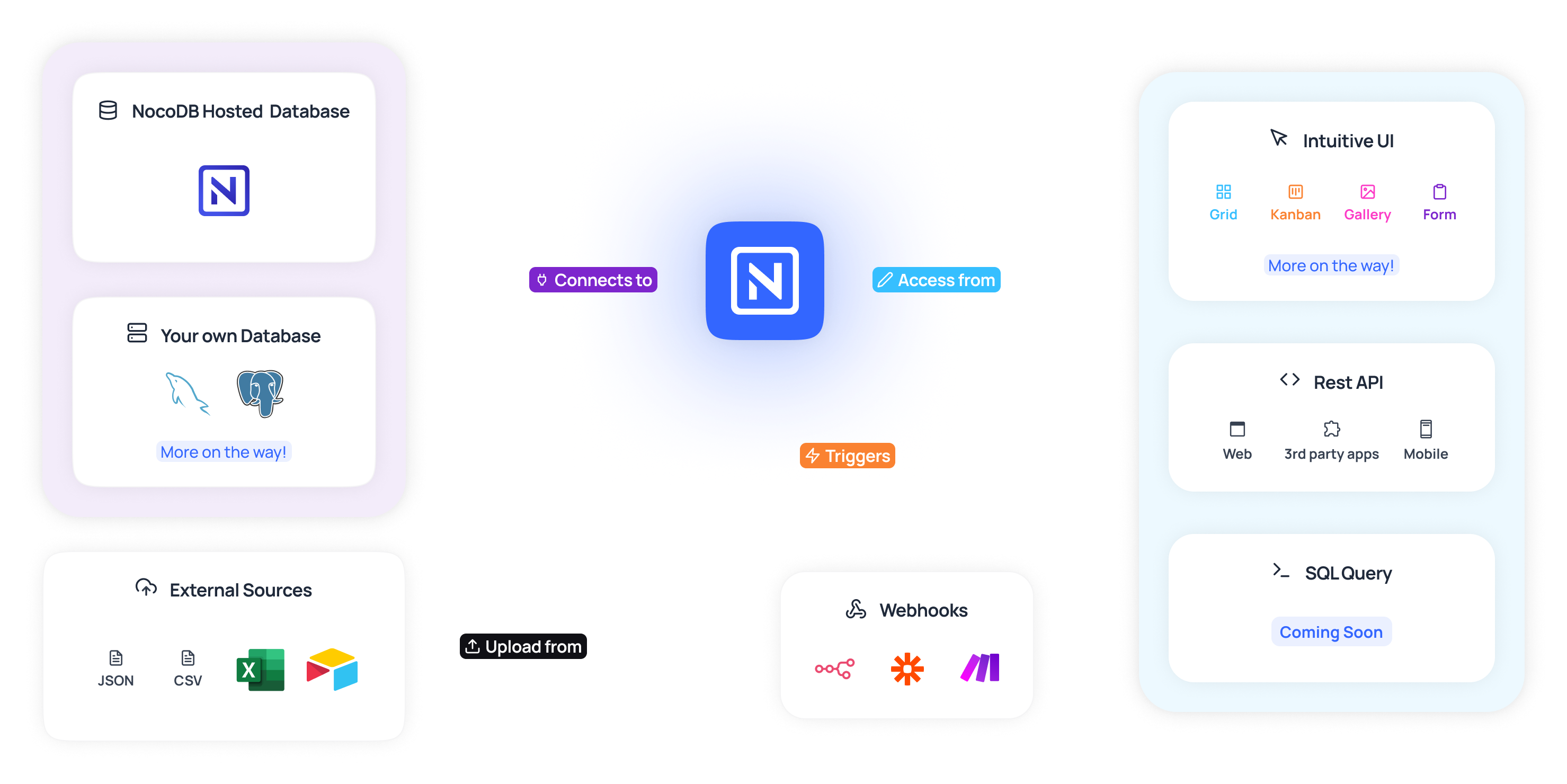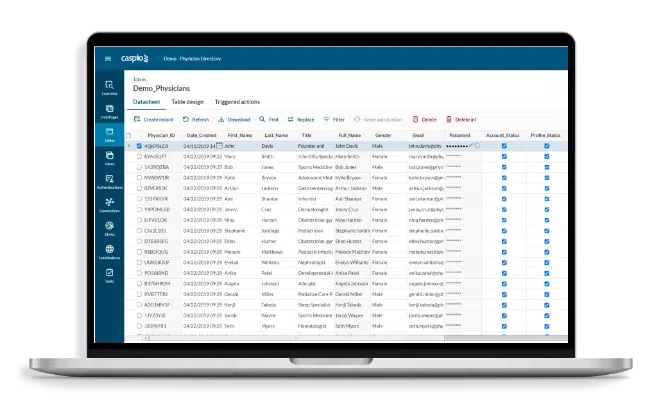Why No-Code is the Future of Open Platform Data Source Creation for Organizations
Why No-Code is the Future of Open Platform Data Source Creation for Organizations
Blog Article
A Comprehensive Guide to Executing Scalable Data Sources Without the Demand for Coding Know-how
In the contemporary landscape of information monitoring, the capability to implement scalable data sources without coding know-how is coming to be progressively crucial for organizations of all sizes. This overview aims to brighten the procedure, concentrating on user-friendly devices and instinctive user interfaces that debunk database arrangement. By checking out crucial features, reliable approaches for implementation, and finest practices for ongoing administration, we will certainly attend to just how even non-technical individuals can with confidence browse this complicated surface. What are the crucial aspects that can absolutely equip these individuals to take advantage of scalable data sources successfully? The responses may redefine your strategy to information management.
Comprehending Scalable Data Sources
In the world of modern data monitoring, scalable data sources have actually arised as an essential option for companies seeking to take care of enhancing volumes of info successfully. These databases are developed to suit development by allowing for the smooth enhancement of sources, whether with straight scaling (adding more devices) or vertical scaling (updating existing devices) This adaptability is crucial in today's busy electronic landscape, where data is created at an extraordinary rate.
Scalable databases usually use dispersed architectures, which enable information to be spread out across several nodes. This distribution not only boosts efficiency but also provides redundancy, making sure information accessibility also in the event of hardware failings. Scalability can be a crucial variable for various applications, consisting of shopping systems, social media networks, and huge information analytics, where customer demand can rise and fall dramatically.
Furthermore, scalable data sources typically feature durable information uniformity models that stabilize performance and integrity. Organizations needs to consider their particular demands, such as read and compose speeds, information integrity, and fault tolerance when selecting a scalable data source remedy. Ultimately, understanding the underlying principles of scalable data sources is essential for businesses intending to prosper in an increasingly data-driven world.
Secret Features to Seek
When assessing scalable data sources, a number of essential attributes are vital to making certain optimum performance and reliability. Take into consideration the design of the data source. A dispersed architecture can boost scalability by allowing data to be stored throughout numerous nodes, promoting smooth information access and processing as need rises.
An additional vital attribute is information dividing, which makes it possible for effective monitoring of huge datasets by splitting them into smaller sized, more manageable items (no-code). This approach not only boosts efficiency however additionally simplifies resource allotment
Furthermore, seek robust duplication capabilities. This attribute guarantees information redundancy and high availability, decreasing downtime during upkeep or unanticipated failings.
Efficiency monitoring devices are also crucial, as they provide real-time understandings into system health and operational efficiency, permitting prompt modifications to preserve optimum efficiency.

User-Friendly Data Source Equipment
Simplicity is a critical aspect in the layout of easy to use database devices, as it enhances accessibility for individuals with differing degrees of technological proficiency. no-code. These tools prioritize instinctive interfaces, allowing customers to create, take care of, and inquiry data sources without calling for substantial programs expertise
Secret features normally consist of drag-and-drop capability, aesthetic data modeling, and pre-built themes that enhance the Continue setup procedure. Such devices often supply guided tutorials or onboarding procedures that help with individual interaction and reduce the understanding curve. Additionally, smooth integration with preferred data resources and services makes certain that individuals can conveniently import and export information, further streamlining procedures.

Moreover, robust assistance and community sources, such as online forums and paperwork, enhance the individual experience by supplying support when required. On the whole, user-friendly database tools encourage organizations to harness the power of scalable data sources, making data management available to every person involved.
Step-by-Step Execution Overview
Just how can companies successfully apply scalable data sources to fulfill their growing information demands? The procedure starts with determining specific information demands, including the quantity, range, and speed of information that will certainly be processed. Next, companies ought to examine user-friendly data source tools that supply scalability functions, such as cloud-based remedies or review handled data source solutions.
Once the right tool is chosen, the following step involves setting up the data source setting. This includes establishing up circumstances, defining user consents, and developing data structures that straighten with organization goals. Organizations must after that move existing data into the new system, ensuring information honesty and very little disturbance to procedures.
Post-migration, carrying out comprehensive screening is critical; this consists of efficiency testing under various load conditions to make certain the system can manage future growth - no-code. Furthermore, it is essential to train team on the data source monitoring interface to facilitate seamless use
Best Practices for Monitoring
Reliable management of scalable databases requires a calculated technique that focuses on ongoing monitoring and optimization. To achieve this, companies should execute durable surveillance devices that give real-time understandings right into database performance metrics, such as query feedback times, resource application, and transaction throughput. Consistently examining these metrics can help identify traffic jams and locations for improvement.

Regular back-ups and calamity recuperation strategies are important to safeguard data honesty and availability. Developing a regular for examining these backups will certainly ensure a trusted recovery procedure in case of an unexpected failure.
Moreover, efficiency adjusting need to be a constant process. Adjusting indexing techniques, maximizing inquiries, and scaling resourcesâEUR" whether vertically or horizontallyâEUR" Our site will assist maintain optimal performance as usage demands advance.
Last but not least, fostering a culture of knowledge sharing among employee will make it possible for continual knowing and adjustment, guaranteeing that the administration of scalable data sources remains efficient and effective gradually.
Verdict
Finally, the execution of scalable databases can be effectively accomplished without coding know-how through the utilization of straightforward devices and user-friendly interfaces. By adhering to the outlined approaches for setup, data migration, and efficiency screening, people can navigate the intricacies of database monitoring with ease. Stressing ideal techniques for continuous upkeep and cooperation further improves the ability to handle scalable data sources successfully in a rapidly progressing data-driven environment.
In the modern landscape of data administration, the capability to implement scalable data sources without coding competence is becoming significantly vital for organizations of all sizes.In the realm of contemporary information administration, scalable data sources have actually emerged as an essential service for companies seeking to manage enhancing volumes of information efficiently.Additionally, scalable databases typically feature robust information uniformity versions that balance efficiency and integrity.How can companies effectively carry out scalable data sources to satisfy their growing information demands? Next, organizations should examine easy to use data source devices that offer scalability attributes, such as cloud-based solutions or managed data source services.
Report this page